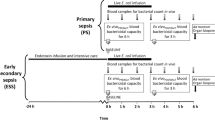Abstract
Sepsis is a significant cause of morbidity and mortality in neonates, and in a significant number of cases no predisposing factors can be identified. We hypothesize that bacterial translocation (BT) may be the etiology of neonatal sepsis when no source is identified. Mesenteric lymph nodes (MLN), spleen (SPL), and liver (LIV) were harvested from 36 rabbit pups ranging in age from 4 to 24 days and divided into three groups based on their age: group I, 4–6 days; group II, 13–15 days; and group III, 22–24 days. Tissues from each organ were homogenized and placed in both aerobic and anaerobic environments. After 48 h the number of colony-forming units/g tissue was identified. The total percentage of positive growth was significantly higher in group I for MLN (33%) and LIV (23%) when compared to groups II and III (<4% for both groups). Gram-negative growth (as selected by MacConkey [MC] media) was significantly higher in all tissue specimens from group I (MLN + 35%, SPL = 20%, LIV = 25%) compared to groups II and III (0% growth in all MC plates, P <0.01). These data support the hypothesis that spontaneous BT occurs with significant frequency in the neonate.
Similar content being viewed by others
References
Deitch E (1990) The role of intestinal barrier failure and bacterial translocation in the development of systemic infection and multiple organ failure. Arch Surg 125: 403–404
Jackson R, Smith S, Wadowsky R, DePudyt L, Rowe M (1991) The effect of E. coli virulence on bacterial translocation and systemic sepsis in the neonatal rabbit model. J Pediatr Surg 26: 483–486
Jones W, Minei J, Barber A, et al (1990) Bacterial translocation and intestinal atrophy after thermal injury and burn wound sepsis. Ann Surg 211: 399–405
Lelli J, Drongowski R, Coran A, Abrams G (1992) Hypoxia-induced bacterial translocation in the puppy. J Pediatr Surg 27: 974–982
Salman F, Buyruk M, Gurler N, Celik A (1992) The effect of surgical trauma on the bacterial translocation from the gut. J Pediatr Surg 27: 802–804
Tokyay R, Zeigler S, Loick H, et al (1992) Mesenteric lymphadenectomy prevents postburn systemic spread of translocated bacteria. Arch Surg 127: 384–388
Zhi-Young S, Yuan-Lin D, Xiao-Hong W (1992) Bacterial translocation and multiple system organ failure in bowel ischemia and reperfusion. J Trauma 32: 148–153
Koloske A (1990) A unifying hypothesis for pathogenesis and prevention of necrotizing enterocolitis. J Pediatr 117: S69-S74
Sullivan B, Swallow C, Girotti M, Rotstein O (1991) Bacterial translocation induces procoagulant activity in tissue macrophages. Arch Surg 126: 586–590
Wells C, Jechorek R, Gillingham K (1991) Relative contributions of host and microbial factors in bacterial translocation. Arch Surg 126: 247–252
Lawrence G, Bates J, Gaul A (1982) Pathogenesis of neonatal necrotizing enterocolitis. Lancet 16: 137–139
Udall J, Pang K, Fritze L, Kleinman R, Walker W (1981) Development of gastrointestinal mucosal barrier. I. The effect of age on intestinal permeability to macromolecules. Pediatr Res 15: 241–244
Wilson R, Kanto W, McCarthy B, et al (1982) Short communication. Age at onset of necrotizing enterocolitis: an epidemiologic analysis. Pediatr Res 16: 82–84
Kanto W, Wilson R, Breart G, et al (1987) Perinatal events and necrotizing enterocolitis in premature infants. Am J Dis Child 141: 167–169
Alverdy J, Aoys E, Moss G (1988) Total parenteral nutrition promotes bacterial translocation from the gut. Surgery 104: 185–190
Alverdy J, Aoys E (1991) The effect of glucocorticoid administration on bacterial translocation. Ann Surg 214: 719–723
Tomaselli V, Van Camp J, Coran A (1995) Intestinal bacterial translocation in the newborn. J Parenter Enter Nutr (in press)
Lassiter H, Christensen R, Parker C, Rothstein G (1988) Neutrophil-mediated killing, opsonization, and serum-mediated killing of Escherichia coli K1 by neonatal rats. Biol Neonate 53: 156–162
Goldman A, Ham Pong A, Goldblum R (1985) Host defenses: development and maternal contributions. Adv Pediatr 32: 71–100
Hanson L, Ahlstedt S, Andersson B, et al (1985) Protective factors in milk and the development of the immune system. Pediatrics 75 [Suppl]: 172–176
Torleiv R, Thrane P, Stoltenberg L, Vege A, Brandtzaeg P (1992) Development of intestinal mucosal immunity in fetal life and the first postnatal months. Pediatr Res 32: 145–149
Walker W, Isselbacher K (1974) Uptake and transport of macromolecules by the intestine. Possible role in clinical disorders. Gastroenterology 67: 531–550
Sherman P, Forstrner J, Forstrner G (1989) Mucosal barrier and its defense during the perinatal period. Human Gastrointestinal Development, Raven Press, New York, pp 687–698
Mata L, Urrutia J (1971) Intestinal colonization of breast-fed children in a rural area of low socioeconomic level. Annals New York Academy of Sciences, INCAP Publication I 519: 93–109
Anderson D, Kliegman R (1991) The relationship of neonatal alimentation practices to the occurrence of endemic necrotizing enterocolitis. Am J Perinatol 8: 62–67
Williams Smith H, Crabb W (1961) The faecal bacterial flora of animals and man: its development in the young. J Pathol Bacterol 82: 53–66
Bennet R, Eriksson M, Tafari N, Nord C (1991) Intestinal bacteria of newborn Ethiopian infants in relation to antibiotic treatment and colonization by potentially pathogenic gram-negative bacteria. Scand J Infect Dis 23: 63–69
Author information
Authors and Affiliations
Rights and permissions
About this article
Cite this article
Van Camp, J.M., Tomaselli, V., Drongowski, R. et al. Bacterial translocation in the newborn rabbit: effect of age on frequency of translocation. Pediatr Surg Int 10, 134–137 (1995). https://doi.org/10.1007/BF00171174
Accepted:
Issue Date:
DOI: https://doi.org/10.1007/BF00171174




